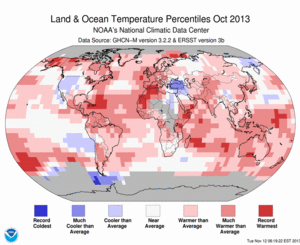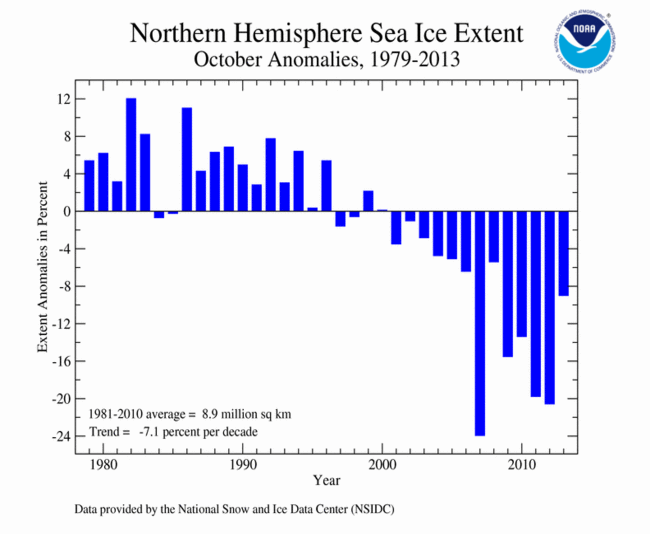Monthly Report Summary Information
The Monthly Report Summary Information is a synopsis of the collection of national and global summaries released each month.
Global Summary Information - October 2013
See Full Report
October 2013 global temperature was the seventh highest on record
The globally-averaged temperature for October 2013 was the seventh warmest October since record keeping began in 1880. October 2013 also marks the 37th consecutive October and 344th consecutive month with a global temperature above the 20th century average.
Many areas of the world experienced higher-than-average monthly temperatures, including Alaska, northwestern Canada, northwestern Africa, and parts of north central and southern Asia. The departure from the 1981–2010 average in these locations varied between +2°C to +5°C or greater. Meanwhile, most of the western half of the United States, northern parts of the Middle East, and parts of central South America, western Russia and the Russian Far East were cooler than average. No land areas around the globe were record cold.
Global temperature highlights: October
- The combined average temperature over global land and ocean surfaces during October was the seventh highest on record for October, at 1.13°F (0.63°C) above the 20th century average. The margin of error associated with this temperature is ±0.13°F (0.07°C).
- October marked the 37th consecutive October and 344th consecutive month with a global temperature above the 20th century average. The last below-average temperature for October was October 1976 and the last below-average temperature for any month was February 1985.
- The global land temperature was the eighth warmest October on record, at 1.76°F (0.98°C) above the 20th century average. The margin of error is ±0.22°F (0.12°C).
- Some national highlights are included below:
- For the 15th consecutive month (since August 2012), Australia experienced above-average temperatures. The nationally averaged October maximum temperature was the third warmest on record with a departure from the 1961–1990 average of +3.8°F. Minimum temperatures were also above average, but did not rank among the top 10 warmest on record. The mean national temperature was 2.57°F above average-the seventh warmest since national temperature records began in 1910.
- Spain experienced warm temperatures during October, with an average monthly temperature 3.8°F above the 1971°2000 average. This resulted in the sixth warmest October since national records began in 1961.
- For the ocean, the October global sea surface temperature was 0.90°F (0.50°C), above the 20th century average, the eighth highest for October. The margin of error is ±0.07°F (0.04°C).
- Neither El Niño nor La Niña conditions were present across the central and eastern equatorial Pacific Ocean during October. According to NOAA's Climate Prediction Center, neutral conditions are favored through the Northern Hemisphere spring 2014.
- Precipitation varied greatly around the globe during October. Above-average precipitation was observed across most of the central United States, Japan, northern India, and parts of northwestern Russia, northern Europe, northern Argentina, and northeastern Brazil. Drier-than-average conditions were present across Australia, Chile, northern South America, western, northeastern and southeastern United States and southern India.
- Australia as a whole experienced its 14th driest October (51 percent below the 1961–1990 average) since national precipitation records began in 1900.
- According to data from the National Snow and Ice Data Center, the average October Arctic sea ice extent was 3.13 million square miles, 9.09 percent below the 1981–2010 average and the sixth smallest October Arctic sea ice extent since satellite records began in 1979 and the first time since 2008 with a sea ice extent above 3.10 million square miles.
- The October Antarctic sea ice extent of 7.50 million square miles was 5.98 percent above the 1981–2010 average, the largest October Antarctic sea ice extent on record.
- According to data from the Rutgers Global Snow Lab, the Northern Hemisphere snow cover extent during October was 8.1 million square miles, 1.3 million square miles above the 1981–2010 average of 6.8 million square miles. This marked the seventh largest October Northern Hemisphere snow cover extent in the 46-year period of record, and the largest since 2009. North America had its 20th largest October snow cover extent, while Eurasia had its fourth largest.
- The first 10 months of 2013 was the seventh warmest such period on record, with a combined global land and ocean average surface temperature of 1.08°F (0.60°C) above the 20th century average of 57.4°F (14.0°C). The margin of error is ±0.18°F (0.10°C).
- The January–October worldwide land surface temperature was 1.67°F (0.93°C) above the 20th century average, marking the seventh warmest such period on record. The margin of error is ±0.40deg;F (0.22°C).
- The global ocean surface temperature for the year-to-date was 0.86°F (0.48°C) above average, tying with 2009 as the seventh warmest such period on record. The margin of error is ±0.07°F (0.04°C).

October 2013 Blended Land and Sea Surface
Temperature Percentiles October 2013 Blended Land & Sea Surface Temperature Anomalies in °C
 NOAA's National Centers for Environmental Information
NOAA's National Centers for Environmental Information


